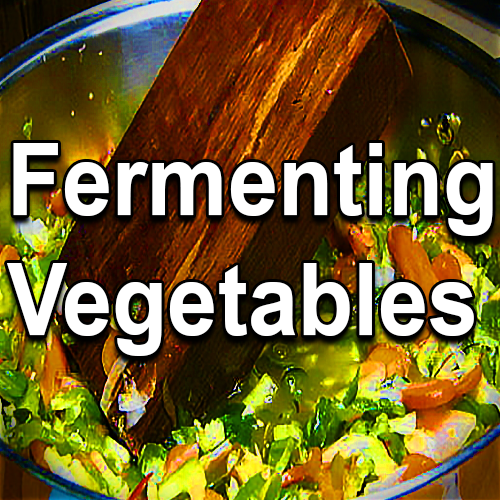Fermenting Vegetables

Fermenting vegetables promotes health.
This is not rocket science, and does not require special skills and elaborate equipment. Instead of buying yogurt, sauerkraut, kimchee or the various other commercially prepared stuff—make your own.
Commercial yogurt may have 1 or 2 types of probiotics—if you are lucky. However, homemade fermented vegetables can have 400 and more kinds of these health promoters.
Fermenting Vegetables Aids Digestion.
Fermenting helps the natural bacteria in the vegetables break down the vegetables into forms that are easier to digest. This can also make the vegetables easier to digest.
Fermenting vegetables can be fun and economic. Also, this can be a low-salt health food that will make you proud.
A knife and a container is all you need.
Do it right in your own kitchen or on your patio. No special equipment and no additives are necessary. These can be fermented right on your table or wherever you can find a place for a jar, mixing bowel, bucket or even a stainless steel pan.
No special precautions are necessary. Furthermore, over the last 10,000 plus years, people didn’t always have access to sanitary facilities—they didn’t even care. They just made the sauerkraut and other fermented vegetables with what they had available.
Make interesting and exotic food at home.
Interesting flavors like your ancestors created—they did it from necessity and you are facing similar circumstances.
How to ferment your own vegetables:
A small head of cabbage, a half dozen carrots, several cloves of garlic, an onion, a green pepper or two, a few stalks of celery, and whatever other vegetables that are available. I am not in favor of using things like potatoes, but suit yourself.
Any and all vegetables are gist for this mill. Add whatever seeds that you have available, like sesame, caraway, dill and hot pepper seeds. Also, add herbs and spices that you like.
- Wash and remove bad spots. I like washing them in a solution apple cider vinegar water or peroxide. Vinegar or hydrogen peroxide can help remove the industrial chemicals that helped get these through the world’s market place. Rinse them well and they are ready.
- Cut, shred, grate, grind or tear into small pieces. I like cabbage sliced into pieces about as thick as a quarter. Carrots can be sliced or grated, garlic diced and green peppers sliced. Use your imagination. If you don’t like to chew food, cut it smaller—even a food processor will work.
Now for the fun part:
- Mix everything together in a pan and add a level tablespoon of salt for each 3 to 5 pounds. The amount is not critical but salt is necessary to favor the good guys over—of course, the bad bacteria. This promotes the lactic acid formation that kills harmful things that might come in. Grab handfuls and get angry at them. Likewise, squash, mutilate, mash and mangle them until the juice comes out.
- Stuff them into a jar, mixing bowel or whatever container is available. Press them down until they are covered with juice. If necessary, add a little water. If you add water, it is a good idea to mix a pinch of salt too—just to keep the brine even.
- I like to keep the vegetables covered with liquid. Additionally, if you have a straight sided vessel, you can use a zip-lock bag with some water to hold them down.
Storage:
Keep them handy and sample them every day until the taste is right for you. Press them under the liquid each day. They will taste good after about five days. At room temperature they need to ferment for 3 to 4 weeks for the fermentation to be completed. Some people like to refrigerate them to arrest the fermentation after a week or so.
However, by that time you may have eaten them all.
Preparation and continuity of effort:
This method only takes a few minutes and a new batch can be made each week. Use whatever vegetables that are in the refrigerator getting too old or just extra. This will give you an interesting and healthy addition to your diet. Don’t be bashful or frightened.
Juniper berries are another nice touch. That might give them a nice touch.
- Resources:
https://www.youtube.com/watch?v=i77hU3zR-fQ Fermenting Vegetables with Sandor Katz
Lacto-Fermentation: The Secret of Healing
| Tags | Category | Author |
|---|---|---|
| Tags: Nutrition | jerry |